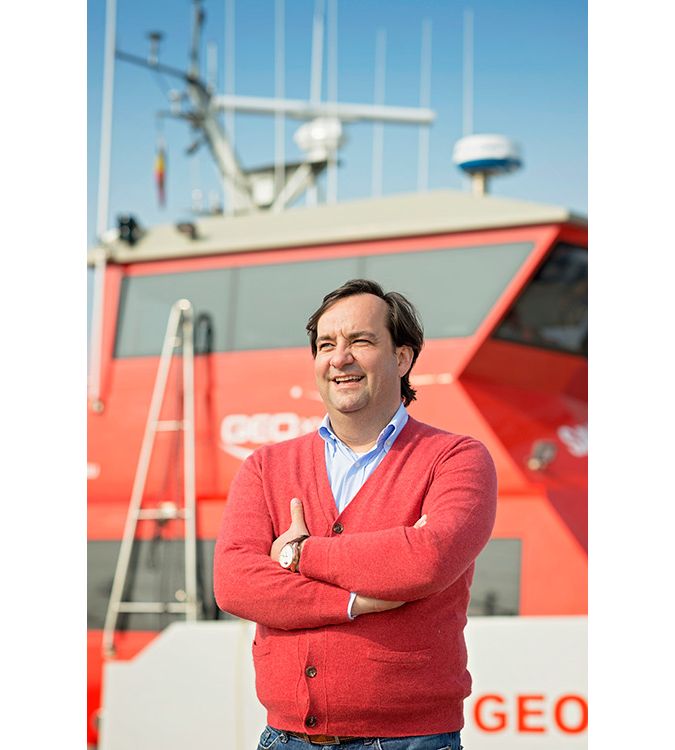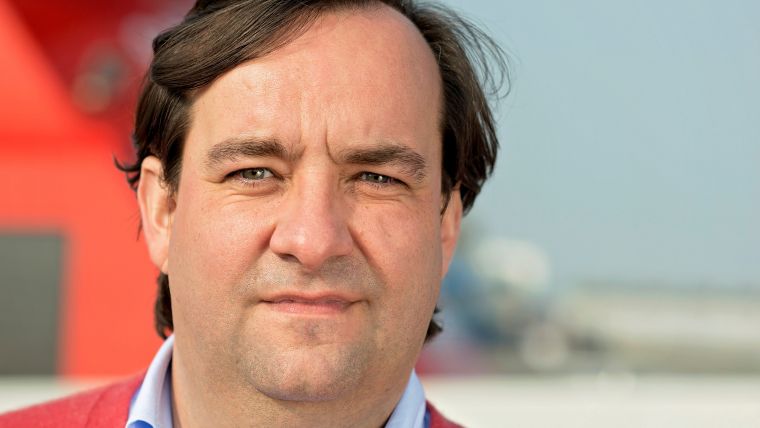Climate change and the energy transition in the hydrographic industry
Q&A with Patrick Reyntjens, GEOxyz
Climate change is having a significant impact on the hydrographic industry, and many organizations are taking steps to reduce emissions and minimize their environmental footprints. Such steps include using more efficient equipment, reducing energy consumption and implementing sustainable operational practices. These efforts are set to continue, while new ways of reducing our carbon emissions are explored and take shape. Here, Patrick Reyntjens, CEO and founder of GEOxyz – a leading service provider focusing on marine surveys and offshore renewable support activities – sheds light on his vision and ambition.
How does climate change affect your business? (This is broader than carbon neutral; the question can also be answered from the business context).
Our people at GEOxyz have a passion for the sea and a strong bond with water and the natural environment. As a service provider, we support our customers in realizing their energy transition goals. In our EU home market and the USA, governments have set clear targets for the energy transition, with an important role for offshore wind energy. We service our clients during the different phases of the life cycle of offshore wind farms (OWFs), by providing site characterization with an aim to deliver insights into the construction risks and status of the future OWF. We provide transfer services of goods and personnel and carry out inspection and maintenance services for OWFs. As OWF initiatives are booming, we are receiving a lot of requests and, to keep up with this demand, GEOxyz has expanded its green fleet.
In April last year, we launched our second hybrid-powered vessel: the Geo Ocean VI. As a result, 50% of our ocean vessels is now hybrid. This means that the carbon emissions per offshore mile are well below the average conventional offshore service vessel. These vessels are also designed to see their engines and battery systems changed over their lifetime, in recognition of the fact that propulsion technology will change before the hull and vessel structure reach the end of their economic lifetimes. Hydrogen can be used as a fuel source to power our electrical engines.
Climate change is actually helping our industry and business to grow. This means that our industry does not just face challenges such as the war for talent seen in every growth sector, but also some specific challenges. The available assets (vessels and instruments) and the speed with which new assets can be delivered in the current market might not be sufficient to cover demand, and the traditional summer survey season has now extended to an all-year-round survey season.
The changing climate and weather patterns and more severe weather events such as storms might influence operations offshore, not just surveys but also the construction and exploitation of offshore assets. While it is clear that we cannot change the forces of nature, we believe that the increased use of robots and drones can address the growing demand for the acquisition of data that is required to help constructors and operators of offshore assets take informed decisions on risk and the nature of their assets.
What does carbon neutral mean for your business?
As a service provider to major energy companies, we help to create a more carbon neutral world, but to deliver our service we create a carbon footprint. We try to minimize our carbon footprint and environmental impact, for example in waste management, and several initiatives are in place and planned at the corporate level.
Which actions have you taken to reduce emissions?
The Geo Ocean V and Geo Ocean VI are hybrid-propulsed electrical/diesel vessels, allowing us to reduce our carbon footprint. Reducing emissions from the fleet is related to fleet renewal, as alternatives to marine fuel are not easy to implement if the vessel is not built for the purpose. GEOxyz currently has a programme in place to develop hydrogen-driven vessels and, where possible, we are switching to biodegradable oils, as long as this does not damage the vessel or the setup. Dronization is also linked to the aim to reduce emissions. We acquired an unmanned vehicle development company in 2019, and have added four ASVs to our fleet and successfully bridged gaps between topographic survey and nearshore bathymetry in several projects in the Baltic and North Sea.
Our offices are equipped with solar panels and we only source green electricity. We also provide company bicycles for use during business hours, and a bicycle allowance to encourage employees to commute by bike. Furthermore, we stimulate the use of electrical vehicles, using green electricity, and have maintained a ‘working from home’ policy, also after COVID-19, as this reduces carbon emissions and does not affect productivity, as we have come to learn.
Which actions do you plan to take in the near future, and in the long term?
Concerning assets, we will continue the greenification and dronization of our fleet. In the near future, we consciously choose to travel by train rather than by plane or car for shorter trips (crew changes, business travel). We will also continue the electrification of our car fleet.
We are actively testing how we can decrease the number of staff on board by QC’ing and processing data through a broad band connection between the survey vessel and shore. Increasing demand for fast deliveries from customers is also pushing us to optimize processes and implement AI and machine learning on our geophysical data, which is a very interesting evolution.
Is there a relationship between unmanned and carbon neutral surveying? For example, fewer people = reduced environmental footprint or less fuel (lighter vessels) = less waste?
Unmanned surveying is the future in the longer term, although mother vessels will still be needed with humans supporting the activities. Specialists will be present in onshore control rooms supporting their colleagues offshore through augmented reality. Having fewer people on a survey vessel has a large impact on the carbon footprint of a project, as it allows the use of smaller vessels and requires less travel.
There are still some technical challenges, such as launch and recovery, the precise positioning of UAVs without surfacing, multisensor platforms capturing data we traditionally collect with towed devices, endurance and data drop-off/communication. While the industry is taking big steps forward for some of these, several challenges still need to be resolved.
As a company, we offer the greenest possible solution that our clients are willing to pay for, allowing us to continue investing in even smaller environmental footprints.
What business opportunities do you foresee in the green economy of renewable energy?
Inspection, repair and maintenance will be combined with inspection surveys during the operational phase of OWFs, and offshore substations or monopiles will act as docking stations for USVs and ASVs. Crew transfer vessels will also act as support vessels and additional data hubs.
Dronization and robotization will also bring us opportunities to increase our value chain, and the more automated processing of data will allow us to deliver in an even more predictable way with a smaller carbon footprint.
Do you have a message for the hydrographic industry regarding climate change and the transition towards a carbon neutral and circular economy?
GEOxyz is a leading service provider, focusing on marine surveys and offshore renewable support activities. As an industry, we should partner, create knowledge networks and motivate each other to achieve the goals of a carbon neutral economy in a financially healthy way.
Our people and company are ready to support the transition towards a carbon neutral and circular economy, and so I invite the industry and operators to contact me to discuss their challenges in going green and circular.
Patrick Reyntjens
Patrick Reyntjens (1975) is the son of a topographic surveyor and founded GEOxyz in 1999 after obtaining his degree as a construction engineer. GEOxyz started as an onshore survey company but Pat’s passion for the sea pushed their activities to nearshore survey and then offshore activities. GEOxyz has established itself as a European leading service provider, focusing on marine surveys and offshore renewable support activities with a fleet of over 20 vessels. GEOxyz is currently active in European waters but looking into further expanding its activities.


Value staying current with hydrography?
Stay on the map with our expertly curated newsletters.
We provide educational insights, industry updates, and inspiring stories from the world of hydrography to help you learn, grow, and navigate your field with confidence. Don't miss out - subscribe today and ensure you're always informed, educated, and inspired by the latest in hydrographic technology and research.
Choose your newsletter(s)
























